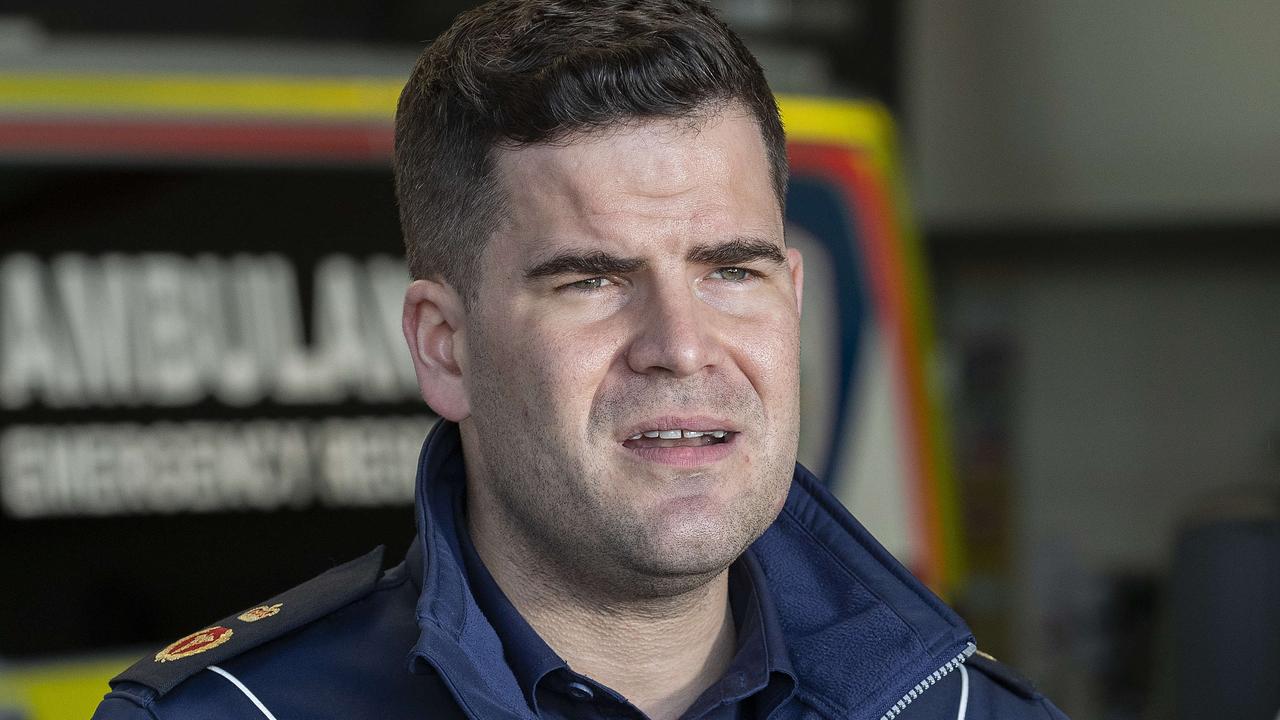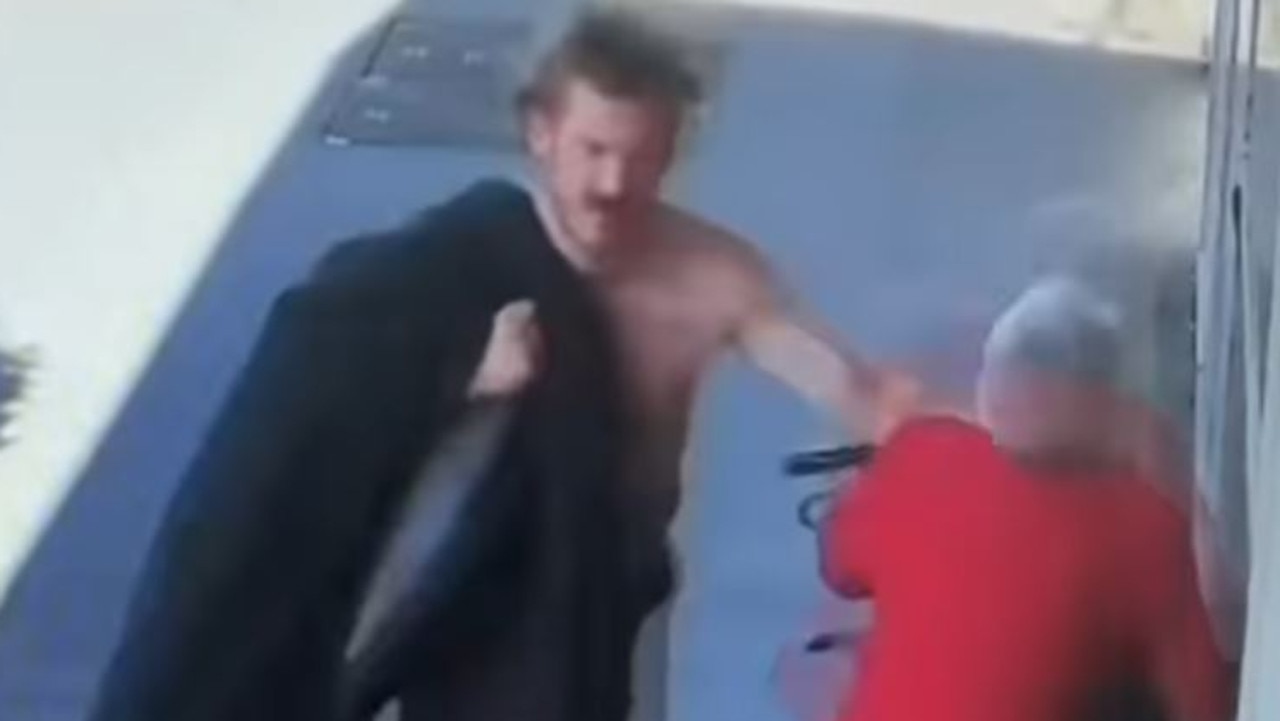Latrobe Valley plunged into 7 day snap lockdown
The Latrobe Valley will enter a seven day lockdown tonight following a rapid increase in Covid cases in recent days.
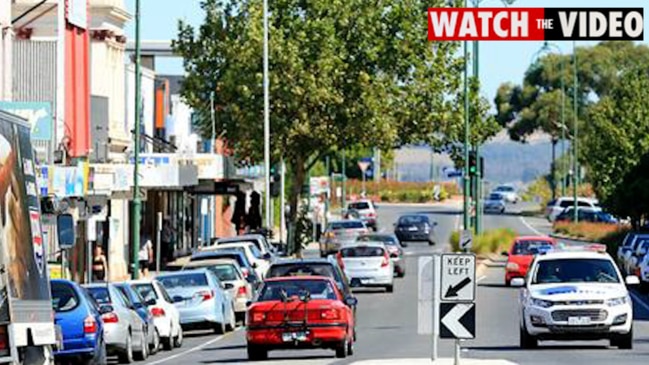
Victoria
Don't miss out on the headlines from Victoria. Followed categories will be added to My News.
• This coronavirus article is unlocked and free to read in the interest of community health and safety. Tap here for our latest great value offer and instantly access trusted news from the Herald Sun and Leader.
The City of Latrobe will enter a seven day lockdown from 11.59pm on Tuesday night following a rapid increase in Covid cases in recent days.
Residents can only leave their home for essential goods and services, caregiving or compassionate reasons, authorised work or permitted education, exercise or outdoor interaction and getting vaccinated.
Locals are not permitted to travel to other parts of regional Victoria unless it is for those reasons.
Shopping, exercise and outdoor social interaction will be limited to 15km from the home for four hours each day.
Residents can meet with one other person, or up to four others from two households if all present are fully vaccinated.
Masks will also be mandatory for both indoors and outdoors settings.
While people can visit their intimate partner or single social bubble buddy, no other visitors will be allowed in the home.
Authorities are urging residents to abide by the health measures and get tested if they are experiencing any symptoms.
“If you’re in the City of Latrobe, please follow the lockdown restrictions, get tested if you have symptoms, and get vaccinated if you haven’t already,” Acting Chief Health Officer Professor Ben Cowie said.
“We’ve just seen the Ballarat and Geelong communities get through an outbreak so we know it can be done – it’s vital we protect the local community and the rest of regional Victoria from significant outbreaks.”
A rapid response team has also been deployed to the area to provide additional support testing, andboost capacity and extend opening hours.
There are coronavirus testing sites in Traralgon, Morwell, and Moe, while capacity will be boosted in Baw Baw and Bass Coast.
There are now 18 active coronavirus cases in the City of Latrobe Local Government Area.
73 per cent of the population has had at least one vaccination dose, while 44% are fully vaccinated.
867 NEW CASES ACROSS VICTORIA
Victoria announced a record 867 new cases on Tuesday, but the number of active cases has risen by more than a thousand thanks to a data glitch.
A software error resulted in 149 cases not being counted over the past two days, with 140 of those missing from Monday’s count.
The number of new cases announced on Monday should have been 845, meaning Victoria had overtaken NSW for the first time since this outbreak started.
NSW Health announced they had recorded 787 local cases in the 24 hours to 8pm on September 26.
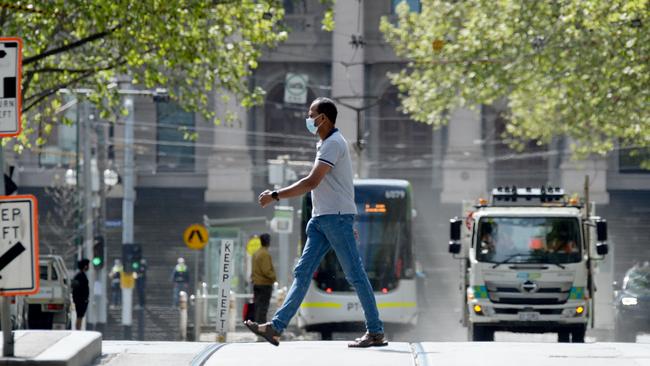
Meanwhile, NSW on Tuesday recorded 863 new local cases and seven deaths in the 24 hours to 8pm on September 27.
The Victorian government had previously welcomed Monday’s numbers as being slightly lower — initially reported as 705 — but they stressed it was too early to draw any conclusions.
A department spokesman said they became aware of the issue “late yesterday”.
“The department became aware that a number of Covid-19 test results were incorrectly recorded by a third-party software vendor supporting a private provider,” a Health Department spokesman said.
“These results included 9 cases reportable on 26 September and 140 cases reportable on 27 September.
“Those 149 cases are reported in today’s numbers – meaning today’s actual case number is 867.”
Health Minister Martin Foley said while the test results had not been reported to the Health Department’s central system, all people who had tested positive had been notified.
Four Covid deaths were recorded on Tuesday. Three of those were unvaccinated with the vaccination status of the fourth person, a woman in her 50s, not yet determined.
35,160 vaccine doses were administered in state-run clinics.
Data reveals 77.9 per cent of Victorians have had their first dose of a Covid vaccine, with 47.7 per cent fully vaccinated.
VICTORIA WON’T MOVE ON PFIZER GAPS
Health Minister Martin Foley has shot down suggestions Victoria should halve the gap between Pfizer doses to speed up vaccination rates.
Mr Foley said the state’s main priority was to ensure enough supply for first-dose Pfizer jabs.
He said authorities needed to guarantee stock levels throughout October before considering cutting wait times from six weeks to three.
“We need to make sure that the vaccine first ring of protection is provided to everyone and that means as soon as we get to that point of protection, then the scheduling of the second dose might well be able to be brought forward,” he said.
“We’re doing a lot of work on that,” he said.
“We hope that the certainty of supply across all three platforms — GPs, pharmacies and state clinics over October — will give us that certainty which will then allow us to bring that gap back to less than six weeks for the mRNA Pfizer and Moderna vaccines.
“That should then bring forward that all-important double dose pictures of 70 and 80 per cent.”
It comes as federal Health Department boss Dr Brendan Murphy revealed the state had enough Pfizer doses to shorten the gap between doses.
Prof Murphy told a Senate committee on Tuesday morning there was now sufficient supply “to bring that forward”.
He said he was sure Victorian authorities were considering that after new supply levels were locked in last Friday.
Health Minister Greg Hunt said the six-week interval between Pfizer shots at state-run clinics was a matter for the Andrews government.
“There is enough supply for every person in Victoria — 100 per cent of people 12 and up — to be double vaccinated before the end of October,” he said.
“The formal TGA approval is for three weeks, the guidance from ATAGI is for three to six weeks.”
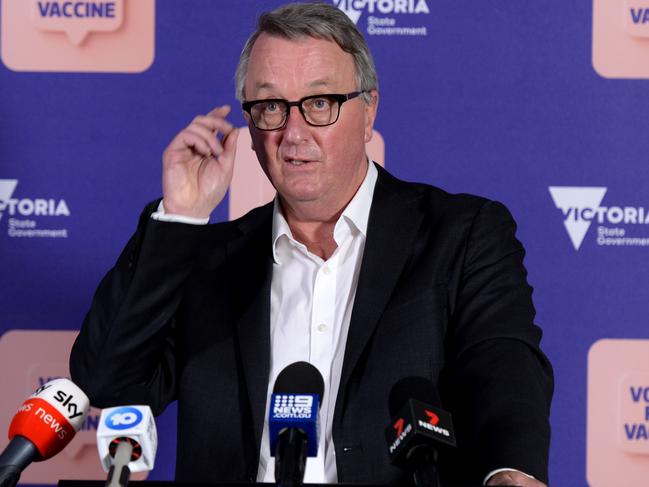
LATROBE VALLEY ON HIGH ALERT
Rapid testing will be rolled out across Victoria’s Latrobe region after infectious people were found out in the community, including at a household gathering on the grand final weekend.
Authorities reported 12 new cases for the shire, with 16 total active cases across three households in Morwell and Traralgon.
A rapid response testing unit has been deployed to the Traralgon Basketball Stadium and more pop-up testing sites will be set up in coming days.
There are concerns that case numbers will continue to grow.
Health Minister Martin Foley said infected people had attended a “social gathering of a number of households” in the Latrobe Valley.
It is not yet known if the gathering was a grand final viewing party but authorities had expressed concern about a rise in illegal gatherings on the weekend.
Mr Foley would not rule out plunging the region into lockdown if case numbers continued to spike.
WHERE VICTORIA’S LATEST CASES EMERGED
• 550 cases in Melbourne’s northern suburbs, including 270 in Hume, 125 in Whittlesea, 88 in Moreland, 43 in Darebin and 24 in Banyule
• 188 in Melbourne’s west including 55 in Melton, 51 in Wyndham, 54 in Brimbank and 28 in Moonee Valley
• 82 cases Melbourne’s southeast, including 45 in Casey, 20 in Port Phillip and 16 in Greater Dandenong
• 38 in Melbourne’s east, including 14 in Maroondah, 14 in Knox and 10 in the Yarra Ranges
• 28 in regional Victoria, including 12 in the Latrobe Valley, five in Mitchell Shire, two in Baw Baw, two in Geelong, one in Corangamite, one in Warrnambool, one in Horsham, one in Gannawarra Shire, one in Macedon and two cases in Shepparton
VICTORIA TRIALS ISOLATION APP
Victorians isolating at home will take part in a pilot program to test a new check-in system.
The app matches selfies with location-based technology to confirm a person is at home, where they are meant to be.
“It will add to the tools to make sure that people are where they’re meant to be and when they’re meant to be,” Health Minister Martin Foley said.
“This will assist Victorians coming back from overseas sooner rather than later.”
AUSSIES TO TEST FOR COVID AT HOME
Australians will soon be able to take a Covid-19 test from the comfort of their home after the federal government gave the green light for do-it-yourself tests to be made available from November 1.
The rapid antigen tests are already widely available for at-home use around the world, including in the UK and US, and provide a result in just 20 minutes.
Health Minister Greg Hunt welcomed the new at-home option, saying it would help Australians adapt to living safely with the virus.
But the Health Minister said it would be up to state and territory leaders whether they would allow at-home testing within their jurisdictions.
Victorian Health Minister Martin Foley would not be drawn on the government’s plan to roll out the tests but said they would be “an important additional tool in the public health response”.
“It won’t replace PCR testing but will give ... greater protection.”
He said the state government was already looking at whether to incorporate rapid antigen testing into its public health plan, and would “work with the commonwealth” before making a decision.
Read the full article here.
RETAIL TURNOVER FALLS AMID LOCKDOWNS
The latest figures from the ABS highlight the impact of Victoria’s latest lockdowns on the retail sector, with turnover down 3 per cent for August.
Australia-wide, retail trade was down by 1.7 per cent month on month, with restrictions in Victoria and NSW (which recorded a drop of 3.5 per cent) pulling down the country’s figures.
Clothing, footwear and personal accessory retail saw the biggest drop (-15.7 per cent) across the country, followed by cafes, department stores (-10.2 per cent), restaurants and takeaway (-7 per cent) and household goods (-2.3 per cent).
Food retail, on the other hand, rose by 2.1 per cent.
Quarterly Economy Wide Surveys director Ben James said “Retail turnover continues to be negatively impacted by lockdown restrictions”.
“Each of the eastern mainland states (experienced) falls in line with their respective level of restrictions,” he said.
“In direct contrast, states with no lockdowns performed well with Western Australia and South Australia enjoying strong rises as physical stores were open for trade.”
Melbourne’s sixth lockdown began on August 5.
FEDERAL GOVT BACKS VIC ROADMAP
Professor Brendan Murphy has backed the roadmaps released by Victoria and New South Wales.
It comes after Daniel Andrews and Glayd Berejiklian were slammed by the peak body for small businesses for ignoring the National Plan to reopen Australia.
NSW Premier Gladys Berejiklian on Monday detailed a new 90 per cent double-vaxxed target for opening up the state, despite the national plan that she and Daniel Andrews signed up to committing to a relaxation of most restrictions at 80 per cent.
In Victoria, Mr Andrews refused to even commit to matching NSW’s proposed freedoms at 90 per cent.
Small Business Australia executive director Bill Lang slammed the “glacial movement to opening up by the premiers”.
“Our political leaders need to understand that business owners and their staff cannot continue to wait,” Mr Lang said.
“Many have been unable to trade for 19 months.
“On behalf of small businesses in NSW and Victoria, Small Business Australia is urging both governments to allow fully vaccinated businesses to trade with those who are fully vaccinated.
“If it is safe for them to do so at 80 per cent, then why is it unsafe for them to trade with each other now?
“What we do not need is time wasted on trials, or goalposts shifting to 90 per cent before businesses can fully trade.
“There is an urgency here that neither Gladys Berejiklian, Daniel Andrews or their health bureaucrats seem to understand and it is time to follow the world by getting our businesses and our people freed – the time for waiting needs to be over.
Daniel Andrews hit back at criticism that Victoria’s recovery road map is out of step with the national plan.
“I’m not quite sure that people who are making that criticism have read the national plan,” he told 3AW on Tuesday.
“Our roadmap is a roadmap to deliver the national plan and why wouldn’t we do that, we helped write the national plan.
“What it says is that you’ve got to open slowly and cautiously because this is now a pandemic of the unvaccinated.
“The unvaccinated group is too big at the moment to open up fully. As that group gets smaller, then we can start to ease and open up, otherwise we’re going to finish up with our nurses given an impossible task.
“This is cautious, it’s measured, but we’ve got that clear plan, and it is absolutely consistent with the national plan.”
The Premier said Victoria would on Tuesday reach its 80 per cent single-dose vax target, two days later than projected, which would guarantee a modest easing of restrictions.
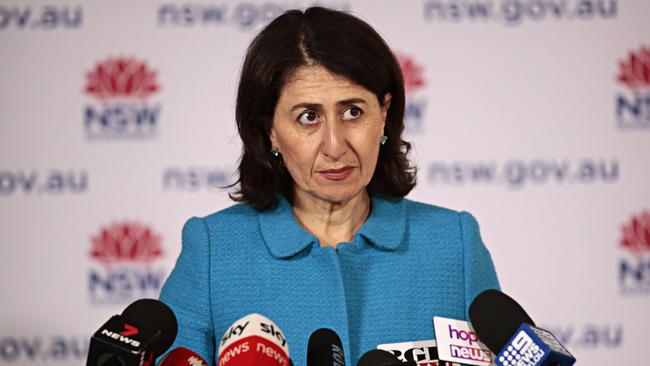
“We’ll get to 70 per cent double dose in just a few weeks time, then 80 only a couple of weeks after that, then lockdowns off, businesses are reopening,” he said.
“We can look to Christmas, 30 people at your house, something like a normal Christmas and look to 2022 with a sense of optimism, because this will be behind us.
“There’ll still be some rules, there’ll be masks in different places, but it’ll be a very, very different year.”
Under a three-stage plan, many freedoms will return for all in NSW on December 1 regardless of their vaccination status, when the state government expects more than 90 per cent of the eligible population to be double-dosed.
Only under that new stage will limits on household visitors and informal outdoor gatherings be scrapped and a one person per 2sq m rule across almost all settings be put in place.
Caps on patron numbers will be ditched and bosses will be able to require staff to return to the office.
Federal Health Minister Greg Hunt said both Victoria and New South Wales were working to the national reopening plan.
Mr Hunt said there were some differences and Victoria’s plan was “very cautious”.
But welcomed the moves to implement the national roadmap.
“I recognise some will proceed at more cautious rates. But all of these plans are about incentives to be vaccinated.”
Prof Murphy said the Doherty Institute modelling showed tighter public health measures needed to be maintained if vaccination thresholds were reached with higher active caseloads, and that it was understood that there would be variations between the states based on the epidemiological situation.
He said that while some states were “more conservative” than others, they had generally agreed to take “first steps” to reopen at 70 per cent and “more significant steps” at 80 per cent.
Appearing before the Senate Covid-19 committee, he said there was always an “element of artificiality” about modelling, and that health authorities were “learning from the real-world experience”.
He said the NSW situation — where high vaccination rates have curtailed the outbreak more quickly than expected — was “pleasing” and would be fed back into the modelling to assist other jurisdictions.
“This is an iterative process,” Prof Murphy said.
Chief Medical Officer Professor Paul Kelly said the national reopening was going “very well” and that the country was “well prepared”.
“Australians need to get used to living with Covid. Every single case is not a tragedy,” he said.
Asked why the Victoria-NSW border remained closed with similar outbreaks in both states, and if there was public health advice to support that restriction, Prof Kelly declined to comment and said the question should be directed to chief health officers in both states.
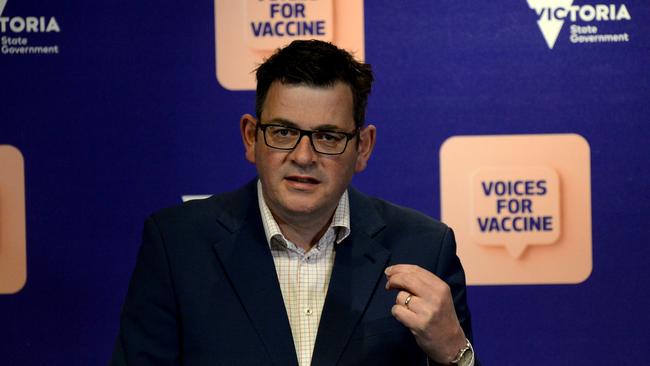
While Small Business Australia condemned the NSW and Victorian premiers, other industry leaders said Mr Andrews should at least match NSW’s plan.
Victorian Chamber of Commerce and Industry chief Paul Guerra said many Victorians would be looking at the NSW road map with envy.
“Unlike us, restaurants, cafes, pubs and bars will not be subject to venue caps when they reach 80 per cent vaccination rates,” he said.
“It is crucial that these caps be removed from the Victorian road map to give the sector the best chance at bouncing back and making the most of the busy festive and summer season.
“Victorian couples and venues also want the same rules for weddings as NSW, where density caps will no longer apply once the 80 per cent double dose level is achieved.”
Under Victoria’s road map a number of restrictions will remain in force even after the state hits an 80 per cent fully vaccinated target, including a cap on visitors to the home, public gatherings, and limits at hospitality venues.
The Victorian government was heavily criticised for not fully consulting industry groups before releasing its road map this month.
But Restaurant & Catering Australia chief Wes Lambert said consultation between industry and the NSW government had been fantastic.
“NSW’s hospitality industry is on cloud nine today and we would like to thank the NSW government for their ongoing consultation during this period,” he said.
“This road map will give certainty in the most uncertain of times. Additionally, the news that weddings will no longer be capped once vax rates reach 80 per cent is a huge win for the industry.”
Under Victoria’s road map, weddings will be capped at 150 vaccinated people indoors and 500 outdoors.
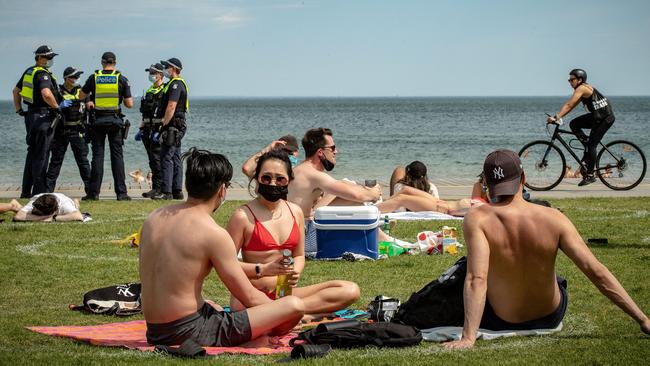
Tim Piper, the Victorian head of the employer association Ai Group, said he would like to see as much conformity as possible between NSW and Victoria.
“They’re the two biggest states and make up for almost 60 per cent of the economy,” Mr Piper said. “Victorians are hanging out for being given the same sort of opportunities as NSW. If we can follow the NSW path, that’s what we should be doing.”
Mr Andrews said Victoria would not follow NSW’s lead.
“We haven’t even had a conversation about when (the vaccinated economy) might change and everyone might be on an equal footing,” the Premier said.
“Over the next few weeks we will be able to watch very closely and see what happens in New South Wales as they open up. What does it mean for their health system and their nurses and doctors? What does it mean for case numbers?”
Duke of Wellington manager Andy O’Brien said having density quotients instead of venue caps would boost profitability for big venues. “If it was regulated by one person per 2sq m we could have up to 488 people,” he said.
TRUCKIE PROTEST FIZZLES OUT
A planned truckie rally that promised to stop traffic on Tuesday morning has failed to materialise as last week’s protesters appeared to lose momentum.
Police pulled over a small number of trucks on the Tullamarine Freeway, but traffic delays are minimal.
Officers have stopped a small convoy inbound on the Freeway near Moreland Rd, a Transport Department spokesman said.
He said there’s only minor delays starting from Bell St with the speed limit lowered to 40km/h when cars drive past police.
“Police are in attendance (and) two lines are closed.”
After promising to turn out “every day”, protesters have shown up in smaller numbers, with police mostly arresting individuals before they could gather in larger groups.
Cops were not taking any chances, with a large presence at a service station near the West Gate Bridge on Tuesday morning.
Police have fined 15 people, after eight trucks were pulled over on the Tullamarine Freeway this morning.
There was a passenger in each truck and the vehicles were driving slow, a police spokesman said.
“Victoria Police is aware some individuals may be planning to participate in a protest on Melbourne’s roads today,” he said.
“Victoria Police will continue (to) have a highly visible presence in the area to maintain public safety, and to ensure any illegal protest activity does not impact on the broader community’s right to go about their daily lives.
“In addition to confirming the chief health officer’s directions are being followed, police will enforce the road rules as required, including the offence of ‘drive in procession’.”
Victorian Transport Association chief executive Peter Anderson condemned “drivers threatening to disrupt people going about their business through protest action today”.
“All disruption will achieve is to undermine already vulnerable supply chains and businesses just trying to survive,” he said.
“Reports suggest up to 10 truck drivers may have protested, but many thousands more have continued working – let’s keep this in perspective.”
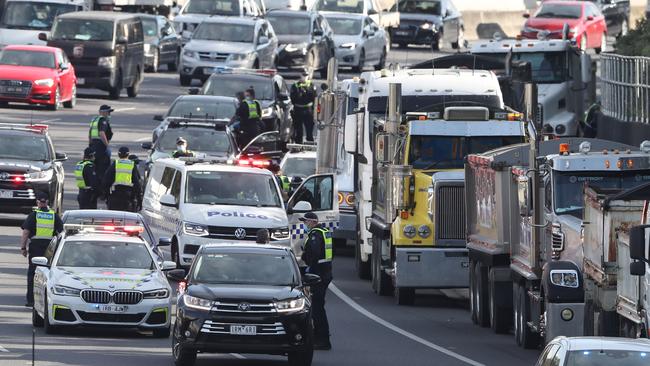
CITY’S NORTH EMBRACES JAB
One in three residents in a critical Covid-ravaged hot spot have had their first vaccine dose in the past month alone, amid a big surge in northern suburbs vaccination rates.
Residents across Hume in Melbourne’s north and Wyndham in Melbourne’s west have rolled up their sleeves in droves over the past four weeks with more than 120,000 first doses administered across both regions.
While first-dose rates had surged above 60 per cent in more than 40 Victorian municipalities – and even hit 86.9 per cent in Queenscliffe – Hume recorded just 40.80 per cent on August 27.
But those rates have rocketed to 73.8 per cent and one in three people aged over 15 are now fully vaccinated.
It comes after the Herald Sun revealed a push from multicultural community leaders in Melbourne’s north and west for an urgent increase in vaccine supply and clinics.
The areas have been the epicentre of Victoria’s third wave with Hume having the most active Covid cases, at 3077.
“What we’ve seen is the community respond and they have responded in overwhelming numbers and we’re so delighted to see that,” Youth Activating Youth director Ahmed Hassan, who was involved in the campaign, said.
“This is not only an increase in numbers, this is saving lives.”
Wyndham in Melbourne’s west has also recorded one of the state’s biggest gains over the past month, with a 33 per cent rise in first doses from 49.7 per cent to 82.8 per cent. The Herald Sun can reveal a pop-up clinic at the Islamic Museum of Australia in Thornbury will begin administering Pfizer and AstraZeneca vaccines from Tuesday.
Founder Moustafa Fahour OAM said four private cubicles would allow women and people with faith and cultural needs to have privacy while they received their vaccines.
“It is about providing places that are easily accessible, comfortable and from trusted community voices,” he said.
GPs and pharmacies across 11 Melbourne municipalities with low vaccination rates will also receive extra funding under a state government plan to turbocharge the rollout.
Grants of between $4000 and $10,000 will be on offer to eligible operators in Brimbank, Cardinia, Casey, Darebin, Greater Dandenong, Hobsons Bay, Hume, Melton, Whittlesea and Wyndham.
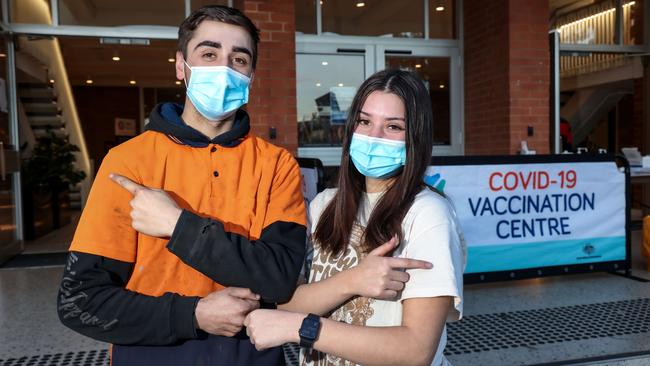
Premier Daniel Andrews said this would allow them to extend trading hours and see more patients.
“They can have more people go through the vaccination program that they are running,” he said.
Victoria is on the way to reaching its vaccine targets with 77.5 per cent of eligible Victorians receiving a single dose of a vaccine, while 47.4 per cent are fully vaccinated.
Victoria recorded 705 new Covid cases and one death on Monday, taking the total number of active cases to 8538.
The Royal Melbourne Hospital shut its Covid testing clinic on Monday as rising active cases put pressure on its emergency department.
A Royal Melbourne Hospital spokeswoman said the Grattan St free clinic, was “closed permanently”.
More than 360 people are in hospital including 75 in ICU.
ANDREWS CONSIDERS CURFEW CHANGE
Daniel Andrews hasn’t ruled out pushing the curfew back to allow Melburnians an extra hour in the sun once daylight saving kicks in.
With clocks to go forward on October 3, the Premier was asked on Monday if the curfew would be adjusted, as it was last year.
“With daylight saving coming, we might have to have a think about the hours of the curfew,” he said.
“I’m not announcing that, that’s not my decision.
“It’s a decision based on the advice from the chief health officer and I don’t have any, but that is a practical matter.”
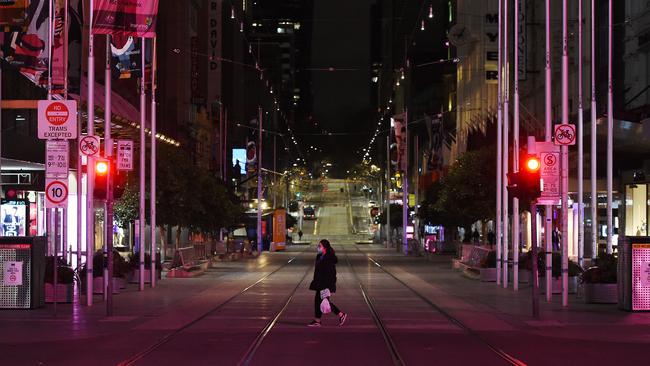
Deakin University chair in epidemiology, Catherine Bennett said “the curfew can go”.
“It doesn’t change any risk and is affecting people in ways that aren’t often recognised,” Professor Bennett said.
She said the curfew stopped shift workers from shopping or exercising late at night — forcing more people to do these activities during the day.
She also said the curfew meant people visiting an intimate partner or single friend had to leave by 9pm, or stay until the next morning. “If they (the government) come back and say they’re constantly finding people out after 9pm, then maybe that’s justification for keeping it,” she said.
“But at this stage we’re yet to see evidence and there is a level of disruption and concentration of people’s activities out of work that is difficult to understand from an epidemiological perspective.”
Melbourne School of Population and Global Health head Nancy Baxter said the 9pm curfew would end — predicted to be about October 26 under the roadmap — when the sun still sets before 8pm.
“I would say that sunset really shouldn’t be setting the timing of the curfew,” she said.
“If it’s getting lighter later, one would think there would be more movement.
“And the whole point of curfew is to reduce movement.”
Melbourne School of Population and Global Health Professor Nathan Grills said the curfew should be scrapped.
“Curfews are a disproportionate measure which further limits already curtailed freedoms and unnecessarily increases community stress,” he said.
Originally published as Latrobe Valley plunged into 7 day snap lockdown



